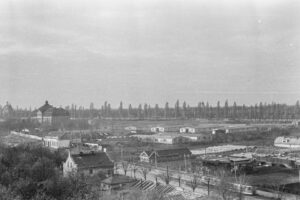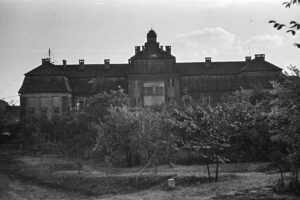- 1201/159 Vinohradská Street
Camp Hagibor
The Art Nouveau building Hagibor served as a home for destitute and ill elderly Jewish citizens until 1943. The structure received its name in the 1920s when a stadium for the Jewish sports club Hagibor (meaning a ‘hero’ in Hebrew) was built adjacent to it.
Early in World War II, Hagibor functioned as an emergency school, refuge, and the last ‘joyful’ place for Jewish children. Beginning in 1944, the building was converted into an internment and transport concentration camp. A year later, due to the war situation, it was turned into an internment camp for collaborators and the German population destined for displacement. There were primarily German refugees from Silesia, Romania, and other regions, along with Hungarian refugees evacuated ahead of the advancing Red Army.
Hagibor became part of the network of provisional internment sites (Camp Rupa Modřany, Camp Hostivař, Strahov stadium, Camp Motol) in Greater Prague, established in May 1945 to temporarily hold approximately 25,000 individuals of German nationality. Additionally, police and court prisons, the Provincial Forced Labour Station in Ruzyně, barrack camps, barracks, public buildings, and schools also served this purpose. Except for a brief period, during which the Red Army used the building for about a month, the camp was in operation until October 1946. As a result of the appalling living conditions, more than 600 people died of exhaustion and malnutrition there.

Hagibor, a camp with the elderly home in the background, 1940s. Jewish Museum in Prague.

View of the rear façade of the elderly home from the garden during the Protectorate of Bohemia and Moravia. Jewish Museum in Prague.



